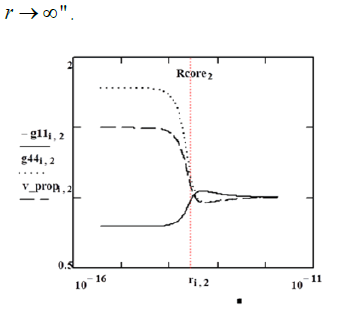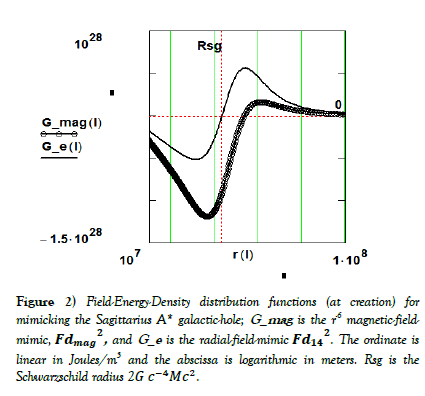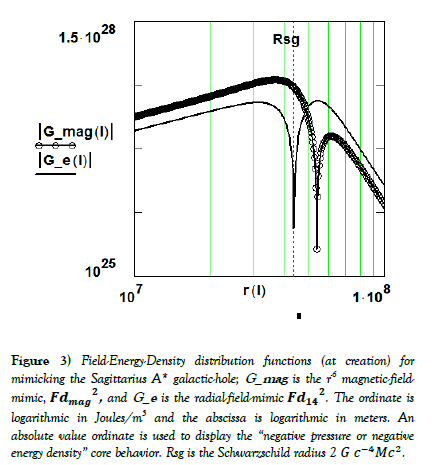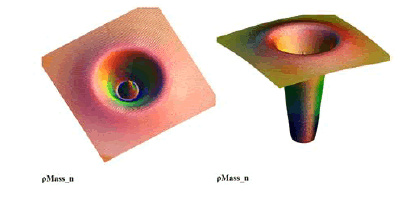Black holes as geometric distortional extrema
Received: 26-Jul-2022, Manuscript No. PULJMAP-22-5202; Editor assigned: 27-Jul-2022, Pre QC No. PULJMAP-22-5202(PQ); Accepted Date: Aug 16, 2022; Reviewed: 29-Jul-2022 QC No. PULJMAP-22-5202(Q); Revised: 29-Jul-2022, Manuscript No. PULJMAP-22-5202(R); Published: 20-Aug-2022, DOI: DOI: No 10.37532/ puljmap.2022 .6(4); 01-08.
Citation: Koehler R D. Black holes as geometric distortional extrema. J Mod Appl Phys. 2022; 6(4):01-08.
This open-access article is distributed under the terms of the Creative Commons Attribution Non-Commercial License (CC BY-NC) (http://creativecommons.org/licenses/by-nc/4.0/), which permits reuse, distribution and reproduction of the article, provided that the original work is properly cited and the reuse is restricted to noncommercial purposes. For commercial reuse, contact reprints@pulsus.com
Abstract
It is shown in the present work that the distorted-space model of matter as extended to extreme curvature limits results in characteristics mimicking those of galactic-black-holes. The distorted-geometry structures exhibit non Newtonian features wherein the hole or core-region fields of the structure are energetically-repulsive (negative pressure), do not behave functionally in an r-4 manner and terminate at zero at the radial origin (no singularity). Of particular interest is that of r-6 energy density behavior at structural radial distances near the core of the distortion, a region also displaying potential-well behavior.
Key Words
Astrophysics; Black Holes; Cosmology; Geometry.
Introduction
The work is a non-conventional mathematically-geometric approach to to describing “black-hole” structures. A comprehensive description or or model of the universe at the fundamental level which improves on the Newtonian r-4 (has an infinity at r = 0 called a singularity) gravitational force model is proposed. Matter and force concepts are to be replaced by more ab initio or first principle energy and geometric-modeling. We have produced a description of the “black hole” as a geometric-mimic, a “distorted geometry” structure, formulated from a solution of Riemann’s geometric equations.
A “Curved empty space as the building material of the physical world” supposition of Clifford in 1876, is the conceptual basis for the present “distorted-geometry modeling”. [1-3] If one models space as a material entity with material qualities, then one can use the fundamental “spacedescribing” geometric equations generated by Riemann; Riemann produced the mathematical-geometric equations necessary to describe ndimensional spaces, 3-dimensional or 4-dimensional or n-dimensional (also think of Pythagoras for 2 dimensional spatial equations). Einstein used Riemann’s geometric equations to describe the impact of gravitational bodies on the “space displaced by the gravitational body. In the present [Curved empty “material” space] modeling, we also use Riemann’s geometric equations to describe a “material space” satisfying a “material descriptor” expressed in Equation (2). Earlier geometricmodeling of “distorted”, or warped spaces was successful in describing fundamental-particles and the ability to describe nuclear forces such as involved in beta-decay (the Fermi-constant; see references.[4] We maintain and expand the geometrical perspectives inherent in the earlier work and building on that work, we apply the geometric concepts to produce a distortional-geometric extremum, a “stability-based minimum-energydensity” condition or “maximum geometrically-distorted gravitational radius” condition. Additionally, we showed in that the propagation velocity in the core region of these distorted-geometry structures was approximately 1.5 times that external to the core (see Fig.1). This feature, which is present for all such material-like, geometrically-produced structures, is equivalent to a “partial light trapping” phenomenon (a black hole core?).
A “geometric maximum-energy-density” feature, in the EM (electromagnetic) energy-density realm, was successfully exploited to geometrically explain and quantify the Fermi constant and in addition a “stability-based minimum-energy-density” condition was fundamental to describing the structure of the “stable distortional-geometry electron” feature. In this perspective, the distorted-geometry model is a departure from the classical geometry model where the Einstein Curvature tensor is the stress-energy-tensor describing the “material contents” of the energy distribution. This distorted-geometry model is rather viewed with the energy-content residing in the warping or distorting of the manifold and therefore in its geometric-tensors, and the “curved empty space” referred to above is a “localized curved or distorted space” devoid of an “external or foreign” causative matter-entity. The “distorted metrics” and the core propagation velocity are displayed for example, for the distorted-geometry electron-mimic in Fig. 1.
The propagation-velocity (energy, information, or radiation), is produced by the geometric “null-geodesic, that is ds2 = 0, and is
 see the metric equation for ds2 preceding eqn. (SI-1). Also see null geodesic. The propagation-velocity is greater than c by virtue of the “material” quality of the “distorted space” and the associated “distorted” metrics g44 and g11 describing that space; mathematical solution to the Riemannian “distorted-space” geometric-equations for μ and νa llows for calculation of g44 and g11 and therefore the propagation velocity. The geometric equations are coupled and non-linear so that the 3-dimensional static forms exhibit a dependence on both the μ and ν variables.
see the metric equation for ds2 preceding eqn. (SI-1). Also see null geodesic. The propagation-velocity is greater than c by virtue of the “material” quality of the “distorted space” and the associated “distorted” metrics g44 and g11 describing that space; mathematical solution to the Riemannian “distorted-space” geometric-equations for μ and νa llows for calculation of g44 and g11 and therefore the propagation velocity. The geometric equations are coupled and non-linear so that the 3-dimensional static forms exhibit a dependence on both the μ and ν variables.
These “distorted metrics” are produced by the “material” equation-of-state, equation (2) below. This energy-propagation-velocity, metric-dependent form (sometimes less than c) applies for any material (solids, liquids, gases, plasmas, spaces). The flat-space propagation-velocity = c because without a space-distorting causative factor, g44 = g11; the flat-space propagation-velocity is used in the special theory of relativity for non-distorted or non-materiallike manifolds and is based on the “assumption” that “space is flat, that is, non-distorted or non-warped”. The “distorted-space black-hole structure”exhibits the distortion effects locally of course and transitions to flat space as” r →∞”.
Theoretical modeling for distortional extrema and holes
Both gravitational and electromagnetic energy-densities are capable of distorting the geometric manifold. This feature of these distorted-space structures is a manifestation of a composite coupling-constant between energy and geometry,

We have used a modified coupling–constant definition by omitting the factor 8π and retaining the factor in the energy-density equations; convent
Functionally,the couplingconstant definition would be 8πκ.
Allowing the distorted space itself to be material in nature, we constrain the modeling by requiring that the descriptive stress-energy tensors satisfy a “constitutive relation” or an “equation-of-state” between the temporal and spatial tensor-curvature elements, namely

We have introduced the explicit distortional-tensor symbolism Td for the geometric quantities. Contrast this perspective with cosmological renditions of geometric curvature structure resulting from “matter” causation, wherein We have introduced the explicit distortional-tensor symbolism Td for the geometric quantities. Contrast this perspective with cosmological renditions of geometric curvature structure resulting from “matter” causation, wherein several “equations of state” relating to the “matter” variables ρ (density) and p (pressure) have been forthcoming where p = σ ρ and where σ varies from -1 to +1[5].
Inherent in the geometric “equation-of-state” constraint is the requirement that the descriptive stress-energy tensor, Td, be Maxwellian in nature; the mimicking process is therefore limited to asymptotically flatspace regions of the manifold since 1/r2 field behavior does not adequately describe elementary-particle structural-detail [6]. The field equations, in both the EM realm and the gravitational realm (Q=0), exhibit r-6 geometric behavior which we have interpreted as constituting a “magnetic monopole” mimic (what is a “magnetic monopole”?).
This description, equation (2), of the distorted-space volume, has led to the universal structural solution, Eq. (SI-5), (see equations (SI-1)-(SI-3) in the SI for variable definitions and for the fundamental Riemann geometric-equation-set leading to equation (SI-4)). These structural geometric equations, (following the symbolism and development of Tolman (referenced as [SI-1] in the SI and as reference [6], are repeated here;
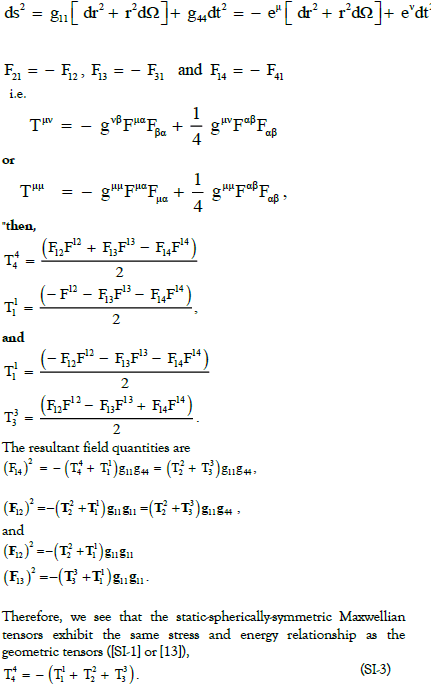
The present geometric-modeling endeavor, with its Maxwellian-tensorform mimicking-component, has produced the fundamental and limiting agent for the currently-studied distorted geometry, namely a particular constraining functional relationship between the geometry-defining tensors (for an empty-space geometry, all of the components of the energy-momentum tensor are zero). In using this simple equation-of-state, equation (SI-2), as a restricting distortional-model tensor relationship, we thereby elicit the metric-defining differential equations for such a family of geometric distortions.
The geometric-energy-density or field equations, after using solution Eq. (SI-4), are repeated here (from [2]). The calculational treatment employs the isotropic coordinate description of equation (SI-1) and utilized by Tolman [13], where the system of equations represented by equation (SI-1), is shown more explicitly in equation in mixed tensor form

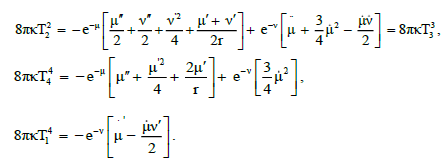
Metric coupling, that is terms such as μ’ν’, are apparent in the fundamental curvature equations. The usual notation, where primes denote differentiation with respect to the radial coordinate r and dots denote differentiation with respect to the time coordinate t, is employed. We are considering the static case (where total differentiation replaces partial differentiation) as was also used for Schwarzschild’s (gravitational) interior and exterior solutions for the model of an incompressible perfect-fluid sphere of constant density surrounded by empty space, [SI-1] or [13]. In that work a zero-pressure surface-condition and matching and normalization of the interior and exterior metrics at the sphere radius were used as boundary conditions.
Tolman has shown that the energy of a “quasi-static isolated system” can be expressed as “an integral extending only over the occupied space”, which we will allow to extend to infinity, and where the total energy of such a sphere is therefore expressed as

This mass-energy representation will be used throughout in calculating the distortional mass-energies. The distortional-tensor energy-density amplitudes manifested in these presently calculated geometric representations are both negative and positive, that is, there are both negative energy-density and positive energy-density regions internal to the distortions. However, the modeled distortions for the mimicked elementary particles all exhibit positive mass-energies. Since geometric distortional fields arise from the same energy-density tensors, the negative energydensity geometric regions are also sources of negative energy-density field quantities. A solution has been found for the metric variables;
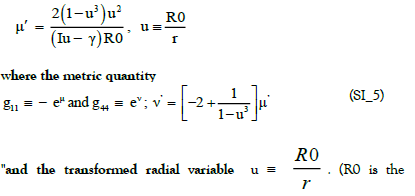 normalizing radius after mimicking EM and gravitational forces). Riemann’s geometric equations are expressed in the metric-variables μ^’ and ν^’ and the manifestation of the composite coupling-constant appears in the geometric quantities “γ” (equation (7)) and the geometric “transformation radius” R0 (equation (7)) both determined from the “distorted spatial volume” with electromagnetic and/or gravitational energy-density components. The final field equations are expressed as,
normalizing radius after mimicking EM and gravitational forces). Riemann’s geometric equations are expressed in the metric-variables μ^’ and ν^’ and the manifestation of the composite coupling-constant appears in the geometric quantities “γ” (equation (7)) and the geometric “transformation radius” R0 (equation (7)) both determined from the “distorted spatial volume” with electromagnetic and/or gravitational energy-density components. The final field equations are expressed as,

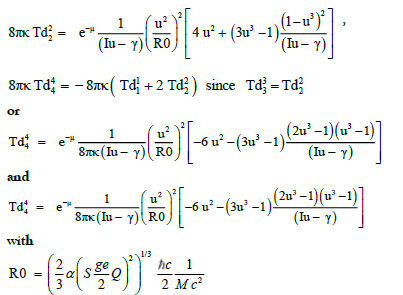
α is the fine structure constant, S is the “spin” quantity, ge is the gyromagnetic ratio, Q is the electric charge number, h is Planck’s constant, c is the velocity of light and M is the mass quantity.
This leads to
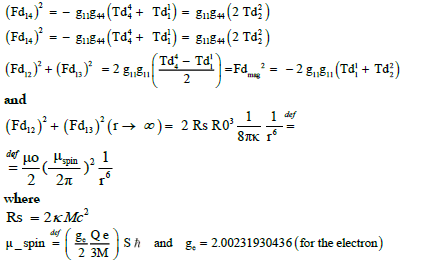
A radial zero in the field quantity ( )2 14 Fd , namely R0≡ Rsgeo = R0geo/ u(r0), with u(r0) = γ(grav)/2 = 3.27512/2, is the geometric manifestation of the Schwarzschild “metric-radial-zero”, the radial singularity classically interpreted as a “black-hole” radius. The core-radius is a fundamental feature of the “distorted-space” structures; it is the radial point at which the energydensity- distortion transitions from a positive shell-like value to a negative core-like value. The structures inherently illustrate r-4, r-6 and repulsiveradial energy-density behavior (relative to the shell energy-density behavior), thereby accounting for Newtonian, weak and strong field-attributes.
In discussions of the negative energy-density core-regions of this universal (EM as well as gravitational) distorted-geometry structure, it should be emphasized that a negative energy-density gravitational feature (a repulsive gravitational force or negative pressure) is non-Newtonian. The hole or core region-fields of the structures are repulsive (relative to the extracore, or shell, region), do not behave functionally in an r-4 manner and terminate at zero at the radial origin (no singularity). See Fig. 2 where the magnetic and radial field energy-densities are graphed for quantitative and qualitative purposes and Fig 3 where the same quantities are shown in absolute values to more clearly identify the relative strengths of these energy densities in the shell to core transition regions. Fig. 4 is constructed to complement the theoretical results exhibited in Figures 2 and 3.
Figure 2: Field-Energy-Density distribution functions (at creation) for mimicking the Sagittarius A* galactic-hole; G_mag is the r-6 magnetic-field-mimic, Fdmag 2, and G_e is the radial-field-mimic Fd14 2 . The ordinate is linear in Joules/m3 and the abscissa is logarithmic in meters. Rsg is the Schwarzschild radius 2G c-4Mc2 .
Figure 3: Field-Energy-Density distribution functions (at creation) for mimicking the Sagittarius A* galactic-hole; G_mag is the r-6 magnetic-field-mimic, Fdmag 2, and G_e is the radial-field-mimic Fd14 2 . The ordinate is logarithmic in Joules/m3 and the abscissa is logarithmic in meters. An absolute value ordinate is used to display the “negative pressure or negative energy density” core behavior. Rsg is the Schwarzschild radius 2 G c-4Mc2 .
Gravitational Hole Modeling Results
We are considering, in the present undertaking, the gravitational energy realm. Incorporating the symbolism utilized in [2], we write equation (3) for the “geometric-maximum-energy-density” feature, the maximum curvature extremum or minimum-radius-extremum, of a “geometric” gravitationaldistortion. In the EM realm, the “geometric-maximum-energy-density” structure is represented by the W-boson which is understood to be the transition-mediator-particle in beta-decay, a high-energy short-lifetime fundamental-particle satisfying the Heisenberg uncertainty principle ΔEΔt = ħ/ 2 .
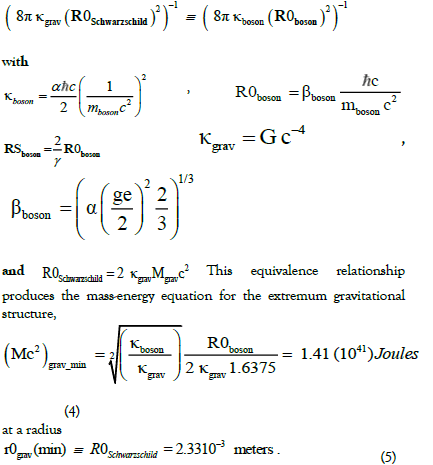
and 2 Schwarzschild grav grav R0 = 2 κ M c This equivalence relationship produces the mass-energy equation for the extremum gravitational structure,
By the same modeling as for the boson, the Heisenberg lifetime would be approximately 10-75 seconds. The Heisenberg lifetime for the W-boson is approximately 10-26 seconds.
Inherent in the “structural-geometric” equations for the boson are their relations to the Fermi constant GF, a measure of the “strength of interaction” in beta decay, which can be written in “distorted geometry” form as,

the latter form of which explicitly illustrates the magnetic –field origin (see equation (SI-6) of the “weak-interaction” as manifested in the “interaction strength” quantity GF and its association with the “geometric-curvature” facet of this “distorted geometry” formalism.
“R0 is the geometric normalization radius “ (R0e is calculated from the fundamental-particle magnetic-field component and R0g is determined from the γ radius-ratio equation for the distorted-geometry structures).
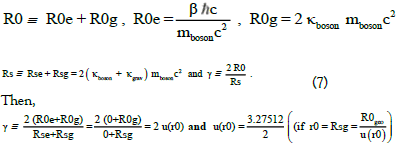
A geometric mimic of a “strength of interaction” constant for gravitationally warped structures would be

where ,

If, in the absence of a physical structural constraint, one posits a “minimum” curvature, or a “minimum” EM-energy-density condition (which was posited for the “electron-mimic” and which is equivalent to a “maximum” geometric EM core-radius) as the “stability” criterion to produce the maximum-core-radius-extremum, distorted-geometry, gravitational-entity, one can write for the electron-mimic,
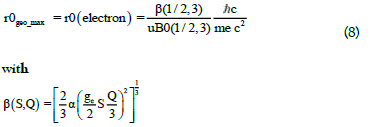
“α = fine structure constant,S is the spin quantity” and ge is the gyromagnetic ratio factor. Then,

By using the associated EM “geometric-energy-density minimum” as the equivalent gravitational constraint for determining a “maximum gravitational core-radius”, and using equation (3) with electron characteristics substituted for boson characteristics, we produce the more classical “HOLE-like” structure; the “distorted-geometry” gravitational Schwarzschild radius is the “hole radius” (see the earlier development in [2] for the Fermi-constant GF where  also see YouTube educational video with included citations Largest Black Holes in the Universe or Wikipedia entry, Black hole ).
also see YouTube educational video with included citations Largest Black Holes in the Universe or Wikipedia entry, Black hole ).
We construct the energy-density relationship (equations (SI-4a) in the SI for ã??“Td” ã??_”4” ^”4” ), calculate the energy-density maximum for the electron and
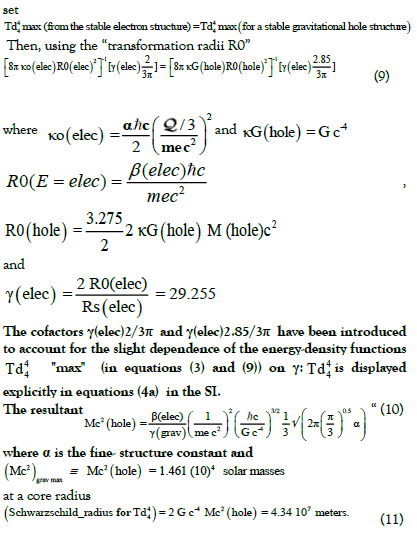
Such a primordial distortional-hole, after 13.8(10)9 years of mass accretion at a rate of 3.01(10)-4 solar-masses/year, would exhibit the present mass of the “Milky Way galactic black-hole (Sagittarius A*)” at 4.154(10)6 solar masses [8,9] and a core (Schwarzschild)-radius of Rsg = 1.23(10)10 meters; its distortional energy-density distribution functions are shown in Fig 5. The distortional peak energy-densities are reduced over this time period from the 1027 Joules/m3 range to a 1023 Joules/m3 range (see Figs. 3 and 5). These extremely high energy-densities (both positive and negative Td integrate to a composite total energy which is the mass-energy of the structure. Also illustrated in Fig. 5 is the Newtonian 1/r4 field energy-density (grav_r) function wherein the “distorted-geometry” function is an order of magnitude greater than the Newtonian function near the core. Functionally the “distorted-geometry-field” transitions to a repulsive core-function at Rsg the Schwarzschild radius. Accreted-mass and the “black hole” constitute a “field-modified energy-altered structure” as, analogously, for example, the neutron, which is unstable when free, but becomes a stable structure when in the nucleus-field-environment[10].
Therefore this “distortional-geometry hole-structure”, created at the “birth of the universe registers as a viable candidate for the structure of “black holes”).
Mass-energy “black-hole” growth rates however range from “~1 solar mass/3000 years (for the Milky Way Galaxy)” up to “~1 solar mass/20 years (for NGC 4594)”, therefore the “Milky Way Black-Hole massaccretion rate” allows for even a “zero-mass black-hole” at creationtime[ 11-15]. Accretion rates are in part based on distance, times and the universe-expansion model and would be subject to revision according to the model selected. The average accreted-hole mass-energy, as calculated from the present-day Universe model is approximately 6.2(10)55 Joules (1/2* mass-energy of NGC 4594). This calculation puts the “galaxy black holes” at 0.17% of the Universe mass-energy if there are 1011 to 1012 galaxies[13]. If the “TON 618 hole” mass-energy (1.19(10)70 Joules) is used to calculate the total “hole mass-energy”, (average ≡ ½ TON 618 mass-energy), at 1012 galaxies, the holes constitute 11% of the total Universe mass-energy. Therefore, “dark gravitational hole entities” might be responsible for most of the posited dark-mass-energy.
This “distorted geometry (DG) Black hole”, a distorted-geometry primordial gravitational-structure, and a “geometric-energy-density minimum” structure (DG_Hole ≡ 2.63(10)51 Joules), along with the “geometric maximum-energy-density” structure, constitute the extrema, the mass-energy bounds of the gravitational-structure particle-spectrum, a range from 1.80(10)41 Joules to 2.63(10)51 Joules. The extrema for electromagnetic structures range from 8.19(10)-14 Joules for the electron to 1.29(10)-8 Joules for the W-boson. The distorted-geometry model, and its “gravitational-mass-energy spectrum” at the maximum energy-density extremum, incorporates the transitory short-lived character (not stable) of a “mediator structure”, a gravitational mimic of the electromagnetic W-boson structure.
Production numbers at creation depend on the “Universe-Creation- Model”utilized , and the mass-energy distribution function. Here we tailor the Planckian “thermodynamically-constructed” black-body radiationemission function to produce a mass-energy-creation, emission and energydistribution function. We incorporate this “Black-Body Mass-energy” function to describe the “Universe-mass-energy” structure and its massenergy emission (at creation) distribution.
The “Universe-mass-energy” ≡ U0 ≡ 5.38(10)70 Joules (however see the “TON 618 hole” mass-energy (1.19(10)70 Joules) cited above ?) and the “mass-energy ratio” for “Milky-Way gravitational-hole” production is ≡ Bu(x = DG_Hole/U0) / DG_Hole = 2.25(10)11, posited as “the number of hole-seeded galaxies”, generated with the Planckian-like mass-energy distribution-function Bu(x);

For N = 1.35 and C0 = 1.69, Bu(x = DG_Hole / U0) / DG_Hole = 2.11(10)12 galaxies. The black body mass-limitation function fBB = 1 in this calculation. The “thermodynamic” Planckian functions Bu(x) and Bu2(x) exhibit no energy-emission limit.
The Distorted-Geometry Black-Body Planckian distribution-function, Bu(x) with N = 1.4, and the classical black-body Planckian radiation-emission distribution-function, Bu2(x) are displayed in Fig.6. Because the Universe, primordially modeled as a black-body, is at an extreme temperature, the galaxy DG-Hole-energy appears in the “uN-1 mass-energy range” and is offscale in the Figure.
Figure 6: Black-Body energy distribution functions; DG-Bu (mass-energy) and Planckian-Bu2 (radiation energy), are expressed in Joules on the logarithmic ordinate scale as a function of mass-energy (Joules) on the logarithmic abscissa. For the classical Planck-distribution, N = 3 and for the posited Universe-energy distribution (2.25 (10)11 hole-seeded galaxies), N = 1.4. The integral function C0 is 1.72 for the Universe-energy distribution and the classical black-body Planckian radiation-energy distribution integral is π4/15U0 is the “Universe mass-energy”.
The mass-energy ratio, “Bu (DG_Hole)) mass-energy-to-hole massenergy”, is postulated to be the number of “hole-seeded-galaxies” and equal to 1011 to 1012 [16, 17]. The density of “dark-matter” in the universe, posited as necessary in the presently accepted Universe-model, is not accounted for in this purely “gravitational-mass-energy spectrum” although a “black body” is considered “dark”.
However these distribution functions do not describe the “Universe as a Black-Body” entity in that the mass-energies exceed the “Universe- Energy” itself; it is a “continuous-energy distribution function” as opposed to a “discrete-energy distribution function”. In the absence of a known experimental mass-energy distribution function, we have posited a modified Planckian distribution function by incorporating the classical 3-dimensional “density of states” function, fBB(x) = (x - 1)2, thereby terminating the Distorted-Geometry Black-Body Planckian distribution function at the “Universe-Energy” U0;
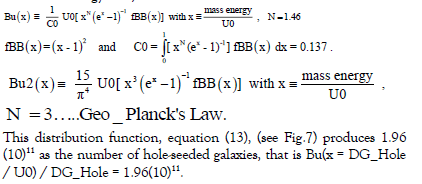
Finally, for hole-like-structure elucidation, it is of interest to examine the ratio of the 1/r6 tensor-component to the 1/r4 tensor-component in the construction of the geometric fields. To further illustrate the structural character of the “distortional-geometry mimics”, we compare at “near-core radial regions” the geometrostatic field quantities Fd14 2 and Fdmag 2. For both gravitational and electromagnetic distortions, the magnetic field component, Fdmag 2, is non-zero at the “radial field zero”, Fd14 2 = 0 , or “core radius”. This field feature would seem responsible for accretion-disk and galaxy-matter rotational-distribution behavior. Actually, the Fdmag 2 fields contain r-6 elements of a magnitude comparable to the magnetic-field strengths Fdmag 2 (see equations (Si-6) in SI), resulting in a significant departure from the classical Newtonian r-4 (or r-6) behavior. The fields exhibit potential-well behavior as they radially transition to repulsion at the hole-core radius.
CONTRIBUTION TO THE FIELD STATEMENT
It has been a comprehensive description or model of “matter in the universe” at the fundamental level, which improves on the “Newtonian r-4 gravitational force model” (mathematically has an infinity at r=0 labelled a singularity), is proposed. Matter and force concepts are to be replaced by more “ab initio” or “first principle” energy-producing, Geometry-based, structural modeling concepts. We have developed a description of matter as a “distorted or warped, non-flat and therefore energy-dense geometric” structure, a geometric-mimic of matter’s defining physical characteristics, formulated from a solution of Riemann’s geometric equations with both an Electromagnetic (EM) and Gravitational coupling-constant[18].
The geometric equations describing the “local region in examination”, a region extending to the “local-origin- r” = 0 since no “matter stress-energyelements” are present, are the 3-dimensional, static, spatial, “Riemannian geometric-curvature equations (1/r2 or 1/r by definition)” [1, 2(pp 264)]. By expressing these geometric-curvature elements (using a spatial 3- dimensional (stationary) spherical-coordinate system with indices (index 1 ≡ radial index r, index 2 ≡ azimuthal index θ and index 3 = azimuthal index Ï?) in “energy-density” form by applying a “stress-energy couplingconstant” (classically a gravitational coupling-constant has been used ), we (classically a gravitational coupling-constant has been used ), we produce a geometrically-based, 3-dimensional, spatial version of the Riemannian “energy-density (matter)” tensors (Joule/meter3)] as a description of the “stressed” region of space.
The model is essentially the “Curved empty space as the building material of the physical world” supposition of Clifford in 1876 and is the conceptual basis for this “distorted-geometry” modeling. Such a geometric description of localized warping or distorting of the spacetime manifold would seem to constitute a “first-principle” model of the universe, achieved only by ascribing to the spatially-distorted (warped) region a “material”, or “distortable”, characteristic.
Early “static-modeling” was accomplished by Schwarzschild [18] (also see Tolman [2, p.245] and see a Wikipedia entry [https://en.wikipedia.org/wiki/Schwarzschild_metric ]) which is quoted here in this regard: “In Einstein’s theory of general relativity, the Schwarzschild metric (also known as the Schwarzschild solution) is an exact solution to the Einstein field equations that describes the gravitational field outside a spherical mass, on the assumption that the electric charge of the mass, angular momentum of the mass, and universal cosmological constant are all zero. The solution is a useful approximation for describing slowly rotating astronomical objects such as many stars and planets, including Earth and the Sun. It was found by Karl Schwarzschild in 1916, and around the same time independently by Johannes Droste, who published his much more complete and modernlooking discussion only four months after Schwarzschild.
According to Birkhoff’s theorem, the Schwarzschild metric is the most general spherically symmetric vacuum solution of the Einstein field equations. A Schwarzschild black hole or static black hole is a black hole that has neither electric charge nor angular momentum. A Schwarzschild black hole is described by the Schwarzschild metric, and cannot be distinguished from any other Schwarzschild black hole except by its mass.”
Clifford’s work, at least his conceptual “Curved empty space as the building material of the physical world” supposition, or the “Space-theory of Matter”, predated Einstein’s concepts and work on General Relativity by 40 years.
Additional work in this field continues, some of which is cited in references [19-23]. The present treatment departs from these cited “constructional methods” in that we do not constrain the warped-geometry descriptions to only gravitational-coupling-constant (G/c4) produced structures.
The task or undertaking of the present work can be stated as follows; “{1} Construct the geometric description (equations) of a static, warped (distorted), spherically-symmetric, localized region of 3-dimensional space satisfying, or being characterized by, a material-like quality expressed as an “equation-of-state”. “[2] Solve said geometric equations and utilize the solutions, if possible, to try to mimic the physical descriptors (characteristics) of matter[24].“
Riemann has provided the basic mathematically-geometric equations to initiate this endeavor. Another quote from Wikipedia [Riemannian_ geometry] reads “Development of Riemannian geometry resulted in synthesis of diverse results concerning the geometry of surfaces and the behavior of geodesics on them, with techniques that can be applied to the study of differentiable manifolds of higher dimensions. It enabled the formulation of Einstein’s general theory of relativity, made profound impact on group theory and representation theory, as well as analysis, and spurred the development of algebraic and differential topology.”
The mathematical rendering of the spatial (3-dimensioal) “stress-energydensity” equations (energy-density geometric-equations describing the warped spatial region), as produced by applying a forcing-function or “geometry-to-physical-energy” translation (a coupling-constant in meters per Joule) to the “Riemannian-geometric-curvature equations” [a mathematical description of multi-dimensional (1,2,3,4….) geometric manifolds (also used in general relativity modeling as detailed above)], are applicable for 3-dimensional spatial static (no time-dependent motion or time-dependent characterization) systems. The Riemannian equations are applicable for time-dependent 4-dimensional systems as well as for 2-dimensional systems, and, in the present rendition with the “distinctively-generated metrics, [Supplementary Information equations (SI-4) through (SI-6)]”, successfully produce an excellent mathematical-representation, (1/r4), of Newtonian gravitational (1/r4) and electromagnetic (1/r4 and 1/r6) energy-densityformulated (think pressure) physical phenomena.
The present resulting geometric description of matter (mass-energy) successfully mimics the classical-physics electromagnetic (EM) and gravitational-field models at large radii of the distorted (warped) region, or energetic-matter region, but the distorted-geometry-regional equations (a description of these same classical forces) depart significantly from Newtonian 1/r4 behavior at small radii (the Newtonian behavior exhibits an infinity at r=0); the geometric equations thereby produce a magnetic-field (spin) matter-mimic as well as a weak-field matter-mimic (beta decay and the Fermiconstant, a force-constant which describes the magnitude of the strength of the weak fields). A strong-field mimic is also mathematically-manifest without an infinity at the origin. There are no infinities or singularities, which are the undesirable hallmarks of pure classical Newtonian and electromagnetic physical models of matter, in these presently, geometrically-constructed, structural models [12].
Classically, physical forces have been characterized as independent entities, each with an associated strength (force constant), a Newtonian gravitational-force, an electromagnetic (electric and magnetic)- force, a weak-force describing the physical phenomenon of beta-decay and a strong-force describing short-range-repulsion effects. These forces are all manifested in the mathematical attributes (force-characteristics or forceconstants) of this ONE distorted-geometric form (the solution to the Riemannian geometric tensor equations 4 3 2 1 4 3 2 1 Td ,Td , Td and Td , that is, the “metric-solution” derived here,
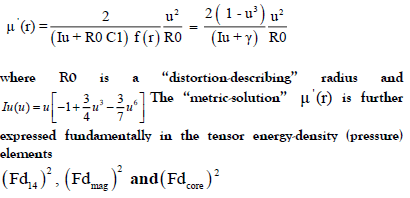
The μ’(r) that “metric solution” satisfies the “Minkowski” requirement that the “Metric-element coefficient-functions must be consistent with T_ μν=0 (empty spacetime in the vicinity of a source mass) and must approach 1 as r approaches infinity, to become the Minkowski metric in spherical coordinates (the metric should be asymptotic flat.)” This present “distorted geometry” “metric solution” satisfies the Minkowski requirement that μ’(r) = 0 at r = ∞, and also intrinsically satisfies the requirement that therefore μ’(r) = 0 at r = 0 producing no infinities.
This “particular form” of the metric quantity μ’(r) is “the solution to the actual metric equation (SI-3)” generated by the “Maxwellian-like” and “material-like” tensor relationships expressed in equations (SI-4) to (SI-6) taken from the SI:

with v’(r)=[-2+f(r)] μ’(r) and u ≡ R0 / r. It should be understood that this equation is the fundamental, constraining or restricting and “defining differential equation for the metric entity ì ′(r) The metric is not arbitrarily defined, it must satisfy this differential equation in the context of, and as dictated by, the Riemannian descriptive geometric-equations (SI-4) and (SI-5); see the SI Supplementary Information for details. Examination of the Maxwellian field quantities F12 and F14 helps in regard to defining f(r) and for the present modeling work, we use the fundamental distortion-defining form

R0 is a distortional-characteristic, or normalizing, radius. The present functional construction can be compared with the Schwarzschild solution [SI-1] in isotropic coordinates where

It will be found in the following development that the simplest (n = 3) distortional form is required to produce zero energy-densities at r = 0, the radial origin of the geometric structure, and a magnetic energy-density mimic at large radii, as well as producing the “metric Schwarzschildian” behavior and the geometric-physical characteristics of the modeled particles.
The inclusion of an “equation of state” as an additional “necessary or constraining” descriptor of “the distorted space, in conjunction with the four Riemann tensor energy-density equations, produces the metricdefining differential equation.
The geometrically-warped structure is constituted by a core-region within which the propagation-velocity, by virtue of the distorted-region metrics, is greater than c and exhibits a “partial light trapping phenomenon”, furthering and duplicating “black hole” behavior. The null geodesic equation and the material quality of the distorted space discussed in the “Introduction” are responsible for this propagation-velocity behavior. Warping or distorting our spatial-manifold requires energy but with limits as to the degree of distortion thereby predicting and describing fundamental-electromagnetic-particle structures as well as gravitational (dark-matter, black-hole) structures.
Discussion
It has been shown in the present work that the distorted-space model of matter, as extended to extreme curvature-limits, results in characteristics mimicking those of galactic-black-holes. The distorted-geometry structures exhibit non-Newtonian features wherein the hole or coreregion fields of the structures are gravitationally-repulsive, do not behave functionally in an r-4 manner and terminate at zero at the radial origin (no singularity) while exhibiting a propagation velocity in the core region approximately 1.5 times that external to the core (light trapping or black hole behavior). Of particular interest is that of r-6 energy-density behavior at structural radial distances near the core of the distortion, a region also displaying potential-well behavior.
SI SUPPLEMENTARY INFORMATION
SUPPLEMENTARY EQUATIONS
For the presently described spherically symmetric Maxwellian case, ϕ, the electrostatic potential, is a function of r alone, and the Maxwellian electromagnetic tensor and the associated field tensor F1μ can be constructed according to equation (3), where the only surviving field tensor components are (following the symbolism and development of Tolman [SI-1]):
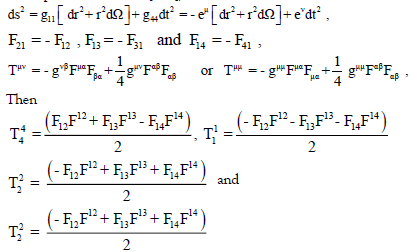
Therefore, we see that the static-spherically-symmetric Maxwellian tensors exhibit the same stress and energy relationship as the geometric tensors [SI-1],

The present geometric-modeling endeavor, with its Maxwellian-tensorform mimicking-component, has produced the fundamental and limiting agent for the currently-studied distorted geometry, namely a particular constraining functional relationship between the geometry-defining tensors (for an empty-space geometry, all of the components of the energy-momentum tensor are zero). In using this simple equation-of-state, equation (5), as a restricting distortional-model tensor relationship, we thereby elicit the metric-defining differential equations for such a family of geometric distortion [25-27].
The geometric-energy-density or field equations (3-5), after using solution Eq. (9) from reference [SI-3]. Koehler, D., SI Supplementary parent “DISTORTIONAL EXTREMA AND HOLES IN THE GEOMETRIC MANIFOLD, https://doi.org/10.21203/rs.3.rs-767026/ v3 have been repeated here (from [SI_2]); also see [SI_1];
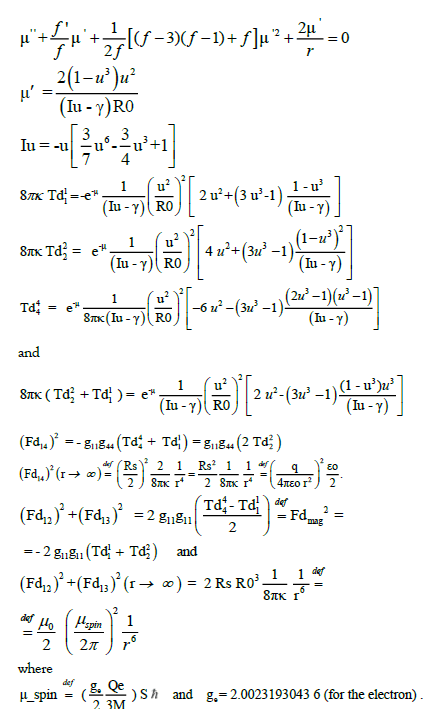
The field equations, in both the EM realm and the gravitational realm (Q = 0), exhibit r-6 geometric behavior which we have interpreted as constituting a “magnetic monopole” mimic (what is a “magnetic monopole” ?).
References
- Clifford WK. On the Space Theory of Matter, Phil. In Proc;1876;2:126-64.
Google scholar Crossref - Koehler DR. Geometric-distortions and physical structure modeling. Indian Jo Phy. 2013;87(10):1029-34.
Google scholar Crossref - Louko J. Geon black holes and quantum field theory. InJournal of Physics: Conference Series. IOP Publishing.2010;222(1):012038.
Google scholar Crossref - Koehler DR. Radiation-Absorption, Geometric-Distortion, and Physical-Structure Modeling. IEEE Trans Plasma Sci.2017;20;45(12):3306-15.
Google scholar Crossref - Linder EV. First Principles of Cosmology. 1997.
Google scholar - Tolman RC. Relativity, thermodynamics, and cosmology. Courier Corporation; 1987.
Google scholar Crossref - Ciufolini I, Wheeler JA. Gravitation and inertia. Princeton university press; 1995.
Google scholar Crossref - Abuter R, Amorim A, Bauböck M, et al. A geometric distance measurement to the Galactic center black hole with 0.3% uncertainty. Astron Astrophys. 2019;625.
Google scholar Crossref - Stevens KA, Schleich K, Witt DM. Non-existence of asymptotically flat geons in (2+ 1) gravity. Classical and Quantum Gravity.2009;26(7):075012.
Google scholar - Lu RS, Krichbaum TP, Roy AL et al. Detection of intrinsic source structure at∼ 3 Schwarzschild radii with millimeter-VLBI observations of SAGITTARIUS A. The Astrophys J.2018;859(1):60.
Google scholar Crossref - Rees MJ, Volonteri M. Massive black holes: formation and evolution. Proceedings of the Int AstronomUnion. 2006;2;51-8.
Google scholar Crossref - Bryson ST, Tenenbaum P, Jenkins JM et al . The Kepler pixel response function. Astrophys J. 2010 ;30;713(2):97.
- Zwart SP, Makino J, McMillan SL, Hut P. Star cluster ecology III: Runaway collisions in young compact star clusters.1998.
Google scholar Crossref - O’leary RM, Rasio FA, Fregeau JM et al. Binary mergers and growth of black holes in dense star clusters. The Astrophys J;637(2):937.
Google scholar Crossref - [Kormendy J, Bender R, Ajhar EA et al. Hubble Space Telescope Spectroscopic Evidence for a 1× 109 M☉ Black Hole in NGC 4594. Astrophys Journal. 1996;473(2):L91.
Google Scholar Crossref - Conselice CJ, Wilkinson A, Duncan K,et al . The evolution of galaxy number density at z< 8 and its implications. Astrophys J.2016;830(2):83.
Google scholar Crossref - Lauer TR, Postman M, Weaver HA et al . New Horizons observations of the cosmic optical background. Astrophy J.202;906(2):77.
Google scholar Crossref - Schwarzschild K. On the gravitational field of a mass point according to Einstein's theory. (1916) 189-96.
Google scholar Crossref - Anderson, P.R.and Brill, D.R. (1997). Phys Rev. D56, 4824-33
- Koehler DR. The Proton and Neutron as Distortional Structures in the Geometric Manifold.2021
Google scholar Crossref - Sones RA. Quantum geons. 2005.
- Stevens KA, Schleich K, Witt DM. Non-existence of asymptotically flat geons in (2+ 1) gravity. Classical and Quantum Gravity.2009;26(7):075012.
Google scholar Crossref - Vollick DN. Addendum to ‘Gravitational geons in 1+ 1 dimensions’. Classical and Quantum Gravity. 2010 Jul 7;27(16):169701.
Google scholar Crossref - Tolman RC. Relativity, thermodynamics, and cosmology. Courier Corporation;1987.
Google scholar Crossref - Koehler DR. Geometric-distortions and physical structure modeling. Indian J Phys. 2013;87(10):1029-34.
Google scholar Crossref - Koehler DR. Geometric Mediator Structures, Transition Dynamics and Force Constants.2021
Google scholar Crossref - Wheeler JA. Geons. Physical Review. 1955 15;97(2):511.
Google scholar Crossref




